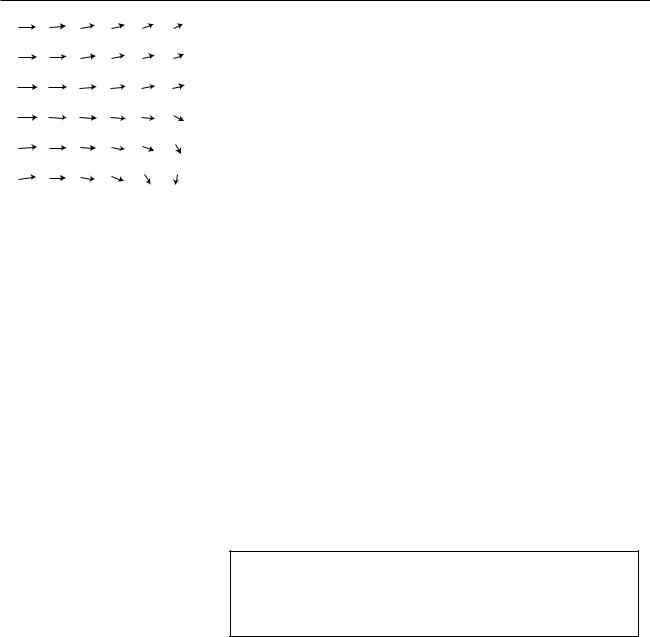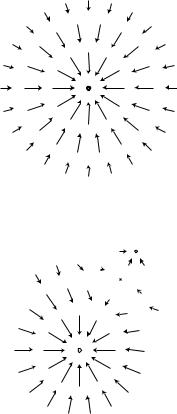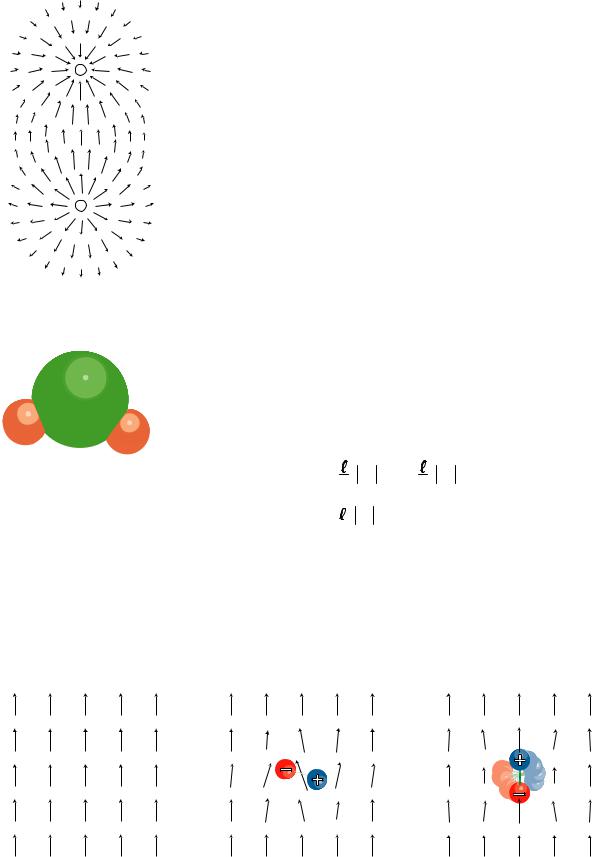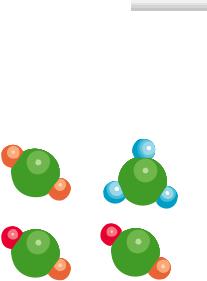
B.Crowell - Electricity and Magnetism, Vol
.4.pdfreleased as it flips back to (c). She has apparently stored energy by going from (c) to (d). So far everything is easily explained without the concept of a field of force.
But now imagine that the two people start in position (c) and then simultaneously flip their magnets extremely quickly to position (e), keeping them lined up with each other the whole time. Imagine, for the sake of argument, that they can do this so quickly that each magnet is reversed while the force signal from the other is still in transit. (For a more realistic example, we’d have to have two radio antennas, not two magnets, but the magnets are easier to visualize.) During the flipping, each magnet is still feeling the forces arising from the way the other magnet used to be oriented. Even though the two magnets stay aligned during the flip, the time delay causes each person to feel resistance as she twists her magnet around. How can this be? Both of them are apparently doing mechanical work, so they must be storing magnetic energy somehow. But in the traditional Newtonian conception of matter interacting via instantaneous forces at a distance, potential energy arises from the relative positions of objects that are interacting via forces. If the magnets never changed their orientations relative to each other, how can any potential energy have been stored?
The only possible answer is that the energy must have gone into the magnetic force ripples crisscrossing the space between the magnets. Fields of force apparently carry energy across space, which is strong evidence that they are real things.
This is perhaps not as radical an idea to us as it was to our ancestors. We are used to the idea that a radio transmitting antenna consumes a great deal of power, and somehow spews it out into the universe. A person working around such an antenna needs to be careful not to get too close to it, since all that energy can easily cook flesh (a painful phenomenon known as an “RF burn”).
Section 5.1 Why Fields? |
111 |

5.2 The Gravitational Field
The wind patterns in a certain area of the ocean could be charted in a “sea of arrows” representation like this. Each arrow represents both the wind’s strength and its direction at a certain location.
Given that fields of force are real, how do we define, measure, and calculate them? A fruitful metaphor will be the wind patterns experienced by a sailing ship. Wherever the ship goes, it will feel a certain amount of force from the wind, and that force will be in a certain direction. The weather is ever-changing, of course, but for now let’s just imagine steady wind patterns. Definitions in physics are operational, i.e. they describe how to measure the thing being defined. The ship’s captain can measure the wind’s “field of force” by going to the location of interest and determining both the direction of the wind and the strength with which it is blowing. Charting all these measurements on a map leads to a depiction of the field of wind force like the one shown in the figure. This is known as the “sea of arrows” method of visualizing a field.
Now let’s see how these concepts are applied to the fundamental force fields of the universe. We’ll start with the gravitational field, which is the easiest to understand. As with the wind patterns, we’ll start by imagining gravity as a static field, even though the existence of the tides proves that there are continual changes in the gravity field in our region of space. Defining the direction of the gravitational field is easy enough: we simply go to the location of interest and measure the direction of the gravitational force on an object, such as a weight tied to the end of a string.
But how should we define the strength of the gravitational field? Gravitational forces are weaker on the moon than on the earth, but we cannot specify the strength of gravity simply by giving a certain number of newtons. The number of newtons of gravitational force depends not just on the strength of the local gravitational field but also on the mass of the object on which we’re testing gravity, our “test mass.” A boulder on the moon feels a stronger gravitational force than a pebble on the earth. We can get around this problem by defining the strength of the gravitational field as the force acting on an object, divided by the object’s mass.
definition of the gravitational field
The gravitational field vector, g, at any location in space is found by placing a test mass mt at that point. The field vector is then given by g=F/mt, where F is the gravitational force on the test mass.
The magnitude of the gravitational field near the surface of the earth is about 9.8 N/kg, and it’s no coincidence that this number looks familiar, or that the symbol g is the same as the one for gravitational acceleration. The force of gravity on a test mass will equal mt g, where g is the gravitational acceleration. Dividing by mt simply gives the gravitational acceleration. Why define a new name and new units for the same old quantity? The main reason is that it prepares us with the right approach for defining other fields.
The most subtle point about all this is that the gravitational field tells us about what forces would be exerted on a test mass by the earth, sun, moon, and the rest of the universe, if we inserted a test mass at the point in question. The field still exists at all the places where we didn’t measure it.
112 |
Chapter 5 Fields of Force |

(a) The gravitational field surrounding a clump of mass such as the earth.
(b) The gravitational fields of the earth and moon superpose. Note how the fields cancel at one point, and how there is no boundary between the interpenetrating fields surrounding the two bodies.
Example: gravitational field of the earth
Question: What is the magnitude of the earth’s gravitational field, in terms of its mass, M, and the distance r from its center?
Solution: Substituting |
F |
|
=GMmt / r 2 into the definition of the |
||
gravitational field, we find |
|
g |
|
=GM / r 2 . |
|
|
|
||||
Sources and sinks
If we make a sea-of-arrows picture of the gravitational fields surrounding the earth, (a), the result is evocative of water going down a drain. For this reason, anything that creates an inward-pointing field around itself is called a sink. The earth is a gravitational sink. The term “source” can refer specifically to things that make outward fields, or it can be used as a more general term for both “outies” and “innies.” However confusing the terminology, we know that gravitational fields are only attractive, so we will never find a region of space with an outward-pointing field pattern.
Knowledge of the field is interchangeable with knowledge of its sources (at least in the case of a static, unchanging field). If aliens saw the earth’s gravitational field pattern they could immediately infer the existence of the planet, and conversely if they knew the mass of the earth they could predict its influence on the surrounding gravitational field.
Superposition of fields
A very important fact about all fields of force is that when there is more than one source (or sink), the fields add according to the rules of vector addition. The gravitational field certainly will have this property, since it is defined in terms of the force on a test mass, and forces add like vectors. Superposition is an important characteristics of waves, so the superposition property of fields is consistent with the idea that disturbances can propagate outward as waves in a field.
Example: reduction in gravity on Io due to Jupiter’s gravity
Question: The average gravitational field on Jupiter’s moon Io is 1.81 N/kg. By how much is this reduced when Jupiter is directly overhead? Io’s orbit has a radius of 4.22x108 m, and Jupiter’s mass is 1.899x1027 kg.
Solution:
By the shell theorem, we can treat Jupiter as if its mass was all concentrated at its center, and likewise for Io. If we visit Io and land at the point where Jupiter is overhead, we are on the same line as these two centers, so the whole problem can be treated one-dimensionally, and vector addition is just like scalar addition. Let’s use positive numbers for downward fields (toward the center of Io) and negative for upward ones. Plugging the appro-
priate data into the expression derived in the previous example, we find that Jupiter’s contribution to the field is –0.71 N/kg. Superposition says that we can find the actual gravitational field by adding up the fields created by Io and Jupiter: 1.81– 0.71=1.1 N/kg.
You might think that this reduction would create some spectacular effects, and make Io an exciting tourist destination. Actually you would not detect any difference if you flew from one side of Io to the other. This is because your body and Io both experience Jupiter’s gravity, so you follow the same orbital curve through the space around Jupiter.
Section 5.2 The Gravitational Field |
113 |

The LIGO detector in Louisiana. More information about LIGO is available on the world wide web at www.ligo.caltech.edu.
Gravitational waves
A source that sits still will create a static field pattern, like a steel ball sitting peacefully on a sheet of rubber. A moving source will create a spreading wave pattern in the field, like a bug thrashing on the surface of a pond. Although we have started with the gravitational field as the simplest example of a static field, stars and planets do more stately gliding than thrashing, so gravitational waves are not easy to detect. Newton’s theory of gravity does not describe gravitational waves, but they are predicted by Einstein’s general theory of relativity. J.H. Taylor and R.A. Hulse were awarded the Nobel Prize in 1993 for giving indirect evidence that Einstein’s waves actually exist. They discovered a pair of exotic, ultra-dense stars called neutron stars orbiting one another very closely, and showed that they were losing orbital energy at the rate predicted by Einstein’s theory. A CalTechMIT collaboration is currently building a pair of gravitational wave detectors called LIGO to search for more direct evidence of gravitational waves. Since they are essentially the most sensitive vibration detectors ever made, they are being built in quiet rural areas, and signals will be compared between them to make sure that they were not due to passing trucks. The project only has enough funding to keep the detectors operating for a few years after they become operational in 2000, and they can only hope that during that time, somewhere in the universe, a sufficiently violent cataclysm will occur to make a detectable gravitational wave. (More accurately, they want the wave to arive in our solar system during that time, although it will have been produced millions of years before.)
5.3 The Electric Field
Definition
The definition of the electric field is directly analogous to, and has the same motivation as, the definition of the gravitational field:
definition of the electric field
The electric field vector, E, at any location in space is found by placing a test charge qt at that point. The electric field vector is then given by E=F/qt, where F is the electric force on the test charge.
Charges are what create electric fields. Unlike gravity, which is always attractive, electricity displays both attraction and repulsion. A positive charge is a source of electric fields, and a negative one is a sink.
The most difficult point about the definition of the electric field is that the force on a negative charge is in the opposite direction compared to the field. This follows from the definition, since dividing a vector by a negative number reverses its direction. It is as though we had some objects that fell upward instead of down.
Self-Check
Find an equation for the magnitude of the field of a single point charge Q. [Answer on the next page.]
114 |
Chapter 5 Fields of Force |

P |
–q |
 q
q
Example: superposition of electric fields
Question: Charges q and –q are at a distance b from each other, as shown in the figure. What is the electric field at the point P, which lies at a third corner of the square?
Solution: The field at P is the vector sum of the fields that would have been created by the two charges independently. Let positive x be to the right and let positive y be up.
Negative charges have fields that point at them, so the charge –q makes a field that points to the right, i.e. has a positive x component. Using the answer to the self-check, we have
E–q,x |
= |
kq/b2 |
E–q,y |
= |
0 . |
Note that if we had blindly ignored the absolute value signs and plugged in –q to the equation, we would have incorrectly concluded that the field went to the left.
By the Pythagorean theorem, the positive charge is at a distance  2b from P, so the magnitude of its contribution to the
2b from P, so the magnitude of its contribution to the
field is kq /
 2b
2b 2 =kq/2b2. Positive charges have fields that point
2 =kq/2b2. Positive charges have fields that point
away from them, so the field vector is at an angle of 135° counterclockwise from the x axis.
E |
q,x |
= (kq/2b2) cos 135° |
|
|
= |
– kq |
|
|
||
|
|
|
|
|
2 |
|
|
|
|
2 2b |
|
||||
|
|
|
|
||||
E |
q,y |
= (kq/2b2) sin 135° |
|||||
|
|
|
|
|
|
|
|
|
|
= |
kq |
|
|
||
|
|
|
|
|
|
|
|
|
|
|
|
|
2 |
|
|
|
|
2 2b |
|
||||
|
|
|
|
||||
The total field is
|
|
kq |
1 |
|||||
Ex |
= |
|
|
1 – |
|
|
||
b 2 |
2 |
|
||||||
2 |
||||||||
Ey |
= |
kq |
|
|
||||
|
|
|
|
|
|
|||
2 |
|
|
b 2 |
|
|
|||
2 |
|
|
||||||
The reasoning is exactly analogous to that used in the previous section to derive an equation for the gravitational field of the Earth. The magnitude of the field is |F|/qt = |kQqt/r2|/qt = k|Q|/r2.
Section 5.3 The Electric Field |
115 |

–
+
(a) A dipole field. Electric fields diverge from a positive charge and converge on a negative charge.
–  –
–
+ +
(b) A water molecule is a dipole.
Dipoles
The simplest set of sources that can occur with electricity but not with gravity is the dipole, (a), consisting of a positive charge and a negative charge with equal magnitudes. More generally, an electric dipole can be any object with an imbalance of positive charge on one side and negative on the other. A water molecule, (b), is a dipole because the electrons tend to shift away from the hydrogen atoms and onto the oxygen atom.
Your microwave oven acts on water molecules with electric fields. Let us imagine what happens if we start with a uniform electric field, (c), made by some external charges, and then insert a dipole, (d), consisting of two charges connected by a rigid rod. The dipole disturbs the field pattern, but more important for our present purposes is that it experiences a torque. In this example, the positive charge feels an upward force, but the negative charge is pulled down. The result is that the dipole wants to align itself with the field, (e). The microwave oven heats food with electrical (and magnetic) waves. The alternation of the torque causes the molecules to wiggle and increase the amount of random motion. The slightly vague definition of a dipole given above can be improved by saying that a dipole is any object that experiences a torque in an electric field.
What determines the torque on a dipole placed in an externally created field? Torque depends on the force, the distance from the axis at which the force is applied, and the angle between the force and the line from the axis to the point of application. Let a dipole consisting of charges +q and –q
separated by a distance  be placed in an external field of magnitude |E|, at an angle θ with respect to the field. The total torque on the dipole is
be placed in an external field of magnitude |E|, at an angle θ with respect to the field. The total torque on the dipole is
τ |
= |
2q E sin θ + 2q E sin θ |
|
= |
q E sin θ . |
(Note that even though the two forces are in opposite directions, the torques do not cancel, because they are both trying to twist the dipole in
the same direction.) The quantity  q is called the dipole moment, notated D. (More complex dipoles can also be assigned a dipole moment — they are defined as having the same dipole moment as the two-charge dipole that would experience the same torque.)
q is called the dipole moment, notated D. (More complex dipoles can also be assigned a dipole moment — they are defined as having the same dipole moment as the two-charge dipole that would experience the same torque.)
+
 –
–
(c) |
(d) |
(e) |
116 |
Chapter 5 Fields of Force |
|

Example: dipole moment of a molecule of NaCl gas
Question: In a molecule of NaCl gas, the center-to-center distance between the two atoms is about 0.6 nm. Assuming that the chlorine completely steals one of the sodium’s electrons, compute this molecule’s dipole moment.
Solution: The dipole moment is
q |
= (6x10 –10 m)(e) |
=(6x10 –10 m)(1.6x10 –19 C)
=1x10 –28 C . m
Alternative definition of the electric field
The behavior of a dipole in an externally created field leads us to an alternative definition of the electric field:
alternative definition of the electric field
The electric field vector, E, at any location in space is defined by observing the torque exerted on a test dipole Dt placed there. The direction of the field is the direction in which the field tends to align a dipole (from – to +), and the field’s magnitude is |E| = τ/Dt sin θ.
The main reason for introducing a second definition for the same concept is that the magnetic field is most easily defined using a similar approach.
Section 5.3 The Electric Field |
117 |

Voltage related to electric field
Voltage is potential energy per unit charge, and electric field is force per unit charge. We can therefore relate voltage and field if we start from the relationship between potential energy and force,
PE |
= |
–Fd |
[assuming constant force and |
|
|
|
|
|
motion parallel to the force], |
and divide by charge, |
|
|
||
PE |
|
= – |
Fd |
[assuming constant force and |
q |
|
q |
||
|
|
|
|
motion parallel to the force], |
giving |
|
|
|
|
V |
= |
–Ed |
|
[assuming constant field and |
|
|
|
|
motion parallel to the field]. |
In other words, the difference in voltage between two points equals the electric field strength multiplied by the distance between them. The interpretation is that a strong electric field is a region of space where the voltage is rapidly changing. By analogy, a steep hillside is a place on the map where the altitude is rapidly changing.
Example: field generated by an electric eel
Question: Suppose an electric eel is 1 m long, and generates a voltage difference of 1000 volts between its head and tail. What is the electric field in the water around it?
Solution: We are only calculating the amount of field, not its direction, so we ignore positive and negative signs. Subject to the possibly inaccurate assumption of a constant field parallel to the eel’s body, we have
E= DV/d
= 1000 V/m .
Example: relating the units of electric field and voltage
From our original definition of the electric field, we expect it to have units of newtons per coulomb, N/C. The example above, however, came out in volts per meter, V/m. Are these inconsistent? Let’s reassure ourselves that this all works. In this kind of situation, the best strategy is usually to simplify the more complex units so that they involve only mks units and coulombs.
Since voltage is defined as potential energy per unit charge, it has units of J/C:
V |
= |
J C |
|
m |
|
||
m |
|||
|
J
= C×m .
To connect joules to newtons, we recall that work equals force times distance, so J=N.m, so
V |
= |
N × m |
|
m |
C×m |
||
|
=N C
As with other such difficulties with electrical units, one quickly begins to recognize frequently occurring combinations.
118 |
Chapter 5 Fields of Force |

Discussion Questions
|
|
|
|
|
|
|
|
|
|
|
|
|
|
|
|
|
|
|
|
|
|
|
|
|
|
|
|
+ |
1 |
|
+ |
2 |
|
|
–– |
|
–– |
|
|
|
|
|
|
+ |
|
|
||
|
+ |
+ – |
|
|
||
|
3 |
|
|
4 |
|
|
–– –
++
Discussion question H.
A. In the definition of the electric field, does the test charge need to be 1 coulomb? Does it need to be positive?
B. Does a charged particle such as an electron or proton feel a force from its own electric field?
C. Is there an electric field surrounding a wall socket that has nothing plugged into it, or a battery that is just sitting on a table?
D. In a flashlight powered by a battery, which way do the electric fields point? What would the fields be like inside the wires? Inside the filament of the bulb? E. Criticize the following statement: “An electric field can be represented by a sea of arrows showing how current is flowing.”
F. The field of a point charge, |E|=kQ/r2, was derived in the self-check above. How would the field pattern of a uniformly charged sphere compare with the field of a point charge?
G. The interior of a perfect electrical conductor in equilibrium must have zero electric field, since otherwise the free charges within it would be drifting in response to the field, and it would not be in equilibrium. What about the field right at the surface of a perfect conductor? Consider the possibility of a field perpendicular to the surface or parallel to it.
H. Compare the dipole moments of the molecules and molecular ions shown in the figure.
I. Small pieces of paper that have not been electrically prepared in any way can be picked up with a charged object such as a charged piece of tape. In our new terminology, we could describe the tape’s charge as inducing a dipole moment in the paper. Can a similar technique be used to induce not just a dipole moment but a charge?
Section 5.3 The Electric Field |
119 |

5.4ò Voltage for Nonuniform Fields
The calculus-savvy reader will have no difficulty generalizing the fieldvoltage relationship to the case of a varying field. The potential energy associated with a varying force is
PE = – F dx |
[one dimension], |
so for electric fields we divide by q to find
V |
= – E dx |
[one dimension]. |
Applying the fundamental theorem of calculus yields
E |
= |
– |
dV |
[one dimension]. |
|
dx |
|||||
|
|
|
|
Example: voltage associated with a point charge
Question: What is the voltage associated with a point charge?
Solution: As derived previously in a self-check, the field is
|E| |
= |
k |
q |
|
r 2 |
||||
|
|
|
The difference in voltage between two points on the same radius line is
V = – E dx
In the general discussion above, x was just a generic name for distance traveled along the line from one point to the other, so in this case x really means r.
|
|
|
r 2 |
|
q |
|
|
|
|
|
|||||
V |
= |
– |
|
|
k |
dr |
|
|
|
||||||
|
|
|
|
|
|
||||||||||
|
|
r |
1 |
|
|
|
r 2 |
|
|
|
|
|
|
||
|
|
|
|
|
1 |
|
|
|
|
1 |
|
||||
|
= |
–kq |
– |
|
– |
– |
|
||||||||
|
|
r1 |
|||||||||||||
|
|
|
|
|
|
|
r2 |
|
|
|
|
||||
|
= |
kq |
|
|
1 |
– |
1 |
|
|
. |
|||||
|
|
|
|
r1 |
|
||||||||||
|
|
|
|
r2 |
|
|
|
|
|
|
|||||
The standard convention is to use r1=∞ as a reference point, so that the voltage is
V |
= |
kq |
. |
|
r |
||||
|
|
|
The interpretation is that if you bring a positive test charge closer to a positive charge, its potential energy is increased; if it was released, it would spring away, releasing this as kinetic energy.
Self-Check
Show that you can recover the expression for the field of a point charge by evaluating the derivative E = –dV/dx.
120 |
Chapter 5 Fields of Force |
